

BIOGEOGRAPHY, PALEOBIOLOGY, AND HUMAN ORIGINS
Bio 4317, Spring 2015
|
|
|
Ecological convergence: hummingbird (New World) and sunbird (Old World)
Biogeography and paleobiology are "big-picture" science without sharp
disciplinary bounds. We draw tools from ecology, evolution,
geology, climatology, etc. to address high-level biological patterns.
Questions concern distribution patterns of plants and animals in space
and time; patterns of biodiversity and the history of these patterns;
and the evolutionary history of the global biota (including
ourselves). We will focus, particularly, on how scientists
pose and address questions where rigorous experimentation is impossible
because of time-frame or spatial scale. There will be some review for
those with strong background in ecology and evolution, but there will
also be new perspectives and extensive new material and ideas.
OFFICE HOURS: Normal office hours are 10-12 am on Tues, Wed, Friday. I'm often around those afternoons as well. If I'm not at my desk, look around adjacent labs and first-floor Dickinson. My office phone is 4465, and email is kwoods@bennington.edu
EXPECTATIONS and EVALUATION
-I
expect regular, on-time attendance;
if
you miss classes frequently and without prior excuse
or
arrangement you cannot complete the course. Lateness is disruptive,
and frequent lateness can also have an impact on your success in the
class.
-
I expect you to be an active participant in the class. That
means doing assigned readings BEFORE class discussions, coming to
class prepared to discuss topics and readings, and generally taking
the work of the class seriously
-
I expect assignments -- several essays and question/problem sets --
to be completed on time; it is your responsibility to examine
assignments sufficiently in advance so that you can bring questions
to me before it is too late
Evaluation will
be based on all aspects of your participation in the class, including
attendance and contribution to classroom discussion. However,
successful completion of written assignments is essential for
successful completion of the course. For those requesting
letter grade, written assignments will account for approximately 70% of
your grade.
BOOKS and READINGS
We have two books, one expensive, the other not so much. You're not required to own either, but important to have regular access. The Lomolino textbook is intended as a general resource and reference; we won't 'follow' it in a concrete way, but you should read chapters listed and bring any questions to class:
-- Lomolino, et al. Biogeography, 4th ed. is the best comprehensive text available. We wonít follow it in detail; itís meant to serve as background reference and resource. READ IT AHEAD OF TIME, and bring questions to class. Itís not essential that you purchase the book, but arrange to have it available.
Ė Dawkins, The Ancestor's Tale: A Pilgrimage to the Dawn of Evolution. An idiosyncratic backward march through the history of life.
There will be other readings from primary and other sources; these WILL serve as vehicles for some of our class discussion, so it is essential that you read these as assigned. These assignments will be posted here (see link above) a couple of weeks in advance. I'll also mention them in class.
TENTATIVE COURSE OUTLINE
This topical outline, along with most other things, is subject to change, and I haven't attempted to attach dates to it. YOU SHOULD STAY ABREAST OF WHERE WE ARE IN THIS FLOW and ask if unclear so as to stay current with text background; numbers following each topic are relevant chapters from Lomolino et al. - but be aware that class discussion and chapters wonít track together in detail. Other readings will be assigned as we go and posted on website; CHECK REGULARLY.
I.
Introduction: Special (and spatial and temporal) problems? (Ch. 1,2)
- questions
and approaches, history and development of biogeography
- space,
time, and scale
HERE
IS A SUMMARY of 'background
concepts'
encompassed in this section; review it and ask questions
II. Macroevolutionary processes (with some review of microevolution)
speciation, extinction, phylogeny and adaptive radiation (Ch.11,12)
III. From the top down; the
timeline, Part 1 (Ch.10)
-
A Pleistocene evolutionary story: the failure of the hominid
evolutionary line (DAWKINS approx first 150 pp)
-
(EARTH PROCESSES ONE: Climate. Ch. 8)
-
Some case studies of phylogenetic reconstruction
IV. Timeline, Part 2
-
Mass extinctions and radiations (Dawkins, second 150 pp)
-
(EARTH PROCESSES TWO: Plate tectonics)
-
Moving onto land
-
Origins of life and first several billion boring years (rest of
Dawkins)
V. Ecological biogeography
- Diversity (Ch. 3,13,14)
- Ranges (Ch. 4,5)
VI. Biogeography of the future: invasions, climate change, etc...
KW - Feb 2015